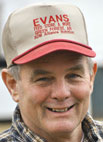
You can take the boy out of the farm, but you can’t take the farm out of the boy. Yes, Bill Schaeffer is pastor of Bible Baptist Church in Omaha, Ark., and head of its preschool through 12th grade school. And, yes, he runs Schaeffer Cedar Sawmill. But at heart he’s first a farmer who loves the Limousin cattle he’s raised since 1998.
That was the year he bought Hercules, a Limousin bull, from Bob and Bobbie Johnson of Tall Tree Limousins, to breed his cow mixes. The Johnsons had been producing breeding stock since 1970, steadily improving their herd and producing the qualities Bill was looking for. Soon, he bought 12 Limousin heifers from the Johnsons and was off and running in building his own herd.
Today, he’s got nearly 60 cows and their calves, heifers he’s holding to replace crossbred cows and eight or nine bulls, among them Hercules and Zorro, one of his sons. They feed year-round on 450 acres in three locations – enough grass for his herd that he doesn’t have to do rotational grazing.
“You need more grass than cows. Don’t graze too short,” he pointed out, adding that he fertilizes in February or March and has found “You get three times as much grass and three times as much protein just by adding fertilizer. If you fertilize, you can run twice as many cattle. It makes the milking better, growing better and breed-back better.”
Four Reasons for Limousin
Having raised Simmental, Angus, Hereford, Charolais, Brahman and Beefmaster cattle in years past, Bill is sold on Limousin for many reasons.
1. Easy calvers – Bill’s calves, born in spring and fall, typically weigh 70 to 80 pounds at birth, but rapidly gain weight from “momma’s milk.” As he pointed out, “People usually have to work off the farm so that’s why calving is No. 1. They don’t have time to follow them around” – as Bill and his 84-year-old father have done. So smaller calves reduce birthing problems.
2. Good milkers – Of all the breeds he’s raised, Limousin cows are the best milkers, rapidly building up their calves.
3. Gentle dispositions – If you’re handling cattle by yourself, as Bill often is, you want cattle that are calm and easy to handle. Bill hasn’t found a more gentle breed – some of his favorites even let him scratch them – though he recommends being calm and non-threatening when around cattle.
4. Easy keepers – Bill’s cows graze year round on fescue and orchard grass and the same kind of hay. The heifers he keeps get about six pounds of 12 percent protein feed a day.
As he walked amongst his cows, softly calling them by name, Bill pointed proudly to their flat backs, broad chests and heavy muscles. Grandson Caleb, 10, moved confidently among the cows with “Poppy,” while 2-year-old Joshua watched from the truck, clearly fascinated by the big rusty red cows milling around the sweet feed his Poppy has strewn on the grass.
“He takes care of his animals like some people take care of their kids,” said his daughter, Linda Cryer.
Bill himself is just glad he has a farm and cows to share with his grandsons. “On a farm, you learn things you can’t learn elsewhere. You learn responsibility and the importance of taking care of your livestock and land,” he said. After his wife of 39 years died in June, he and his grandsons put in a late garden that produced phenomenally. “They’re learning where food comes from,” he smiled.







